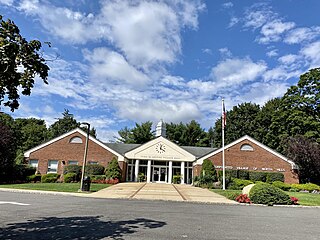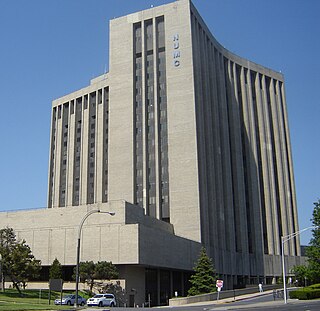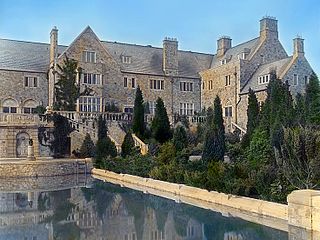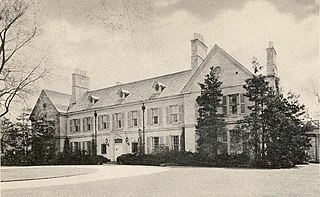
East Hills is a village in Nassau County, on the North Shore of Long Island, in New York, United States. It is considered part of the Greater Roslyn area, which is anchored by the Incorporated Village of Roslyn. The population was 7,284 at the time of the 2020 census.

East Meadow is a hamlet and census-designated place (CDP) in the Town of Hempstead in Nassau County, on Long Island, in New York, United States. The population was 36,856 at the time of the 2024 census.

Flower Hill is a village in Nassau County, on the North Shore of Long Island, in New York, United States. The eastern half is considered part of the Greater Roslyn area, which is anchored by the Incorporated Village of Roslyn. Western and northern parts are more closely associated with Manhasset and Port Washington. The population was 4,794 at the time of the 2020 census.

North Hills is a village in the Town of North Hempstead in Nassau County, on the North Shore of Long Island, in New York, United States. The population was 5,464 at the 2020 census.

Roslyn Harbor is a village in Nassau County, on the North Shore of Long Island, in New York, United States. It is considered part of the Greater Roslyn area, which is anchored by the Incorporated Village of Roslyn. The population was 1,067 at the time of the 2020 census.

The North Shore of Long Island is the area along the northern coast of New York's Long Island bordering Long Island Sound. Known for its extreme wealth and lavish estates, the North Shore exploded into affluence at the turn of the 20th century, earning it the nickname the Gold Coast. Historically, this term refers to the affluent coastline neighborhoods of the towns of North Hempstead and Oyster Bay in Nassau County and Huntington in Suffolk County. Some definitions may also include the parts of Smithtown that face the Sound. The region is also largely coextensive with the Gold Coast region of Long Island, though this region excludes Smithtown, as the easternmost Gold Coast mansion is the Geissler Estate, located just west of Indian Hills Country Club in the Fort Salonga section of Huntington.

Coindre Hall, originally called West Neck Farm, is a 40-room, 80,000-square-foot (7,400 m2) mansion in the style of a medieval French château completed in 1912 for pharmaceutical magnate George McKesson Brown. Coindre Hall sits on 33 acres (13 ha) of rolling land overlooking Huntington Harbor, near the Long Island Sound.
Harold Irving Pratt was an American oil industrialist and philanthropist. A director of Standard Oil of New Jersey, he also served on the Council of Foreign Relations from 1923 to 1939.

Nassau University Medical Center (NUMC) is a public teaching hospital affiliated with the Health Sciences Center of Stony Brook University and with Northwell Health. The 19-story, 631-bed Level I Trauma Center is located at 2201 Hempstead Turnpike in East Meadow, in Nassau County, on Long Island, New York.
Babb, Cook & Willard was a New York City-based architectural firm established in 1884 that designed many important houses and commercial buildings. The principals of the firm were George Fletcher Babb (1836–1915), Walter Cook (1843–1916), and Daniel W. Willard. Willard left the firm in 1908, and was replaced by Winthrop A. Welch. The firm was subsequently renamed Babb, Cook and Welch until 1912, when it became Cook and Welch.
Arnold Asa Saltzman was an American businessman, diplomat, art collector, and philanthropist, based in New York.

Welwyn Preserve County Park is a 204-acre (0.83 km2) public nature reserve in Glen Cove, on the North Shore of Long Island in the U.S. state of New York.

Killenworth is a historic mansion in Glen Cove, New York constructed for George Dupont Pratt in 1912. It was purchased by the Soviet Union in 1946 to become the country retreat of the Soviet, and later Russian, delegation to the United Nations. In the 1980s the property was subject to allegations it was being used for espionage. There has been a long-standing conflict with the City of Glen Cove over its tax status.

Poplar Hill is a historic mansion in Glen Cove, New York. Constructed for Frederic B. Pratt in 1925, it has been in use as a healthcare center since 1947, and is currently known as the Glengariff Healthcare Center.

The Manor is a historic mansion in Glen Cove, New York. It was constructed in 1910 as the home of John Teele Pratt and Ruth Baker Pratt. It was designed by Charles A. Platt.

Glen Cove Hospital is a hospital in Glen Cove, New York, United States, that is part of the Northwell Health system. It was founded in 1921 and moved to its current location in 1927. From 1927 to 1955, it was known as North Country Community Hospital, and at other times it had various names referencing Glen Cove.
Chanticlare was a large, Gold Coast-era estate located in the Village of Flower Hill, on the North Shore of Long Island, in New York, United States.

Strathmore is an unincorporated, Levitt & Sons-developed hamlet in the Town of North Hempstead in Nassau County, on the North Shore of Long Island, in New York, United States, within the census-designated place (CDP) of Manhasset.
Siegmund "Sig" Spiegel was a Jewish architect, war hero, author, activist, and Holocaust lecturer. A German-American, he fled Nazi Germany to the United States in 1938, following his sister. As an architect he was best known for his extensive work in the New York Metropolitan area.


















